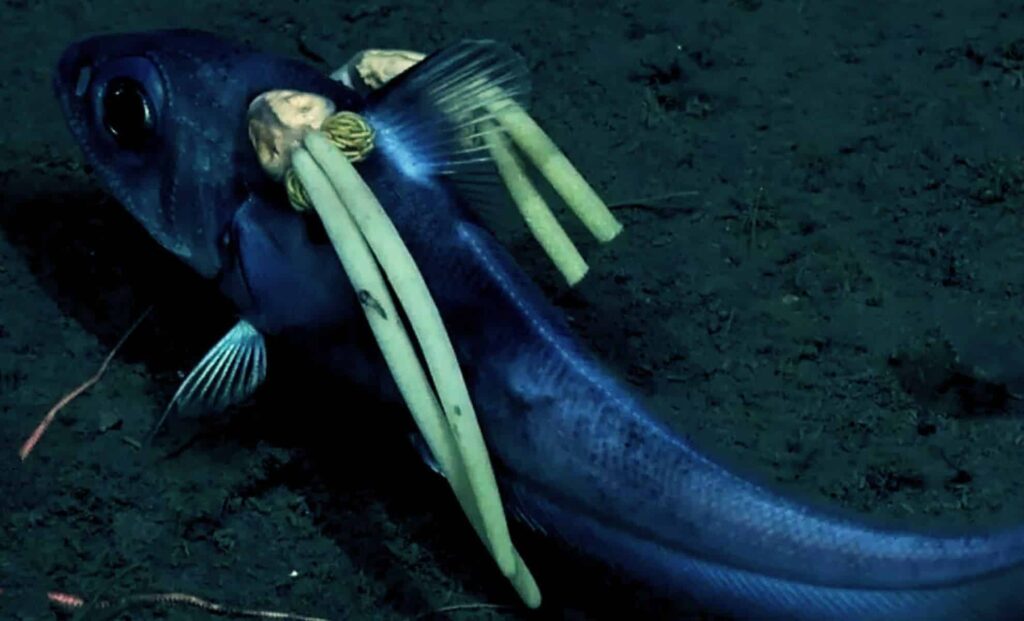In the cold, dark waters off the coast of the South Sandwich Islands, an astonishing discovery has recently emerged, casting light on the hidden complexities of deep-sea life. The Schmidt Ocean Institute captured footage that offers a rare glimpse into the bizarre and sometimes unsettling interactions of the ocean’s deep inhabitants. What appeared at first to be natural appendages of a fish turned out to be something far more disturbing: bloodsucking parasites, consuming their host alive. The sight is both chilling and fascinating.
A Descent into the Depths
This unprecedented footage was filmed during an expedition focused on exploring the seabed and documenting the biodiversity of the South Sandwich Islands, a volcanic archipelago in the South Atlantic. The region’s deep waters, about 489 meters below the surface, have long been difficult to explore due to the extreme conditions and remoteness.
Yet, during this mission, researchers were able to capture the rare behavior of a rattail fish (Macrourus), which was found with two parasites latched onto its head. These parasites, identified as copepods from the species Lophoura szidati, are known for their bloodsucking tendencies, but this footage provides a rare opportunity to witness their feeding process up close.
The Parasite’s Grasp
The parasites, which appear almost like pigtails due to their egg sacs, are part of a group called mesoparasites. These copepods are embedded in the fish’s skin, feeding off the fish’s blood and muscle tissue. Their bodies protrude from the fish, while the anterior portions remain deeply anchored inside the fish’s head.
As James Bernot, an evolutionary biologist at the Smithsonian National Museum of Natural History, explained, these copepods are uniquely adapted to their parasitic lifestyle. They are capable of feeding on their host for months, with their larvae initially burrowing into the fish’s skin and gradually maturing into full-grown parasites.
“The copepods are surprisingly good mothers for invertebrates,” Bernot said, highlighting how these creatures carry their eggs in sacs attached to their bodies, providing a form of maternal care uncommon among such small marine organisms.
A Lifelong Attachment
The parasitic relationship observed in this footage is not a fleeting interaction. The copepods begin their life as larvae that burrow into the host’s skin, feeding on blood and muscle tissue. Over time, they mature into parasites that are permanently anchored to their host. Even after death, remnants of the copepod’s head can remain embedded in the fish for years. This long-term attachment underscores the significant biological impact these parasites have on their hosts and the larger marine ecosystem.

Copepods, like those captured in this footage, have a fascinating life cycle. The larvae undergo metamorphosis and develop anterior holdfasts, specialized structures that allow them to securely anchor themselves to their host. As they grow, the parasites feed on the fish’s tissues, a process that can last for several months before the parasites reproduce, continuing the cycle.
The Role of Parasites in Ocean Ecosystems
Though often viewed with distaste, parasites like these copepods serve an important role in marine ecosystems. They help regulate populations of host species, preventing overpopulation and maintaining balance within the food web.
Lauren Dykman, a researcher at the Woods Hole Oceanographic Institution, explained that parasites play a key role in maintaining the health of ecosystems. “Diverse, functioning, healthy ecosystems actually have a higher diversity and abundance of parasites,” she noted, suggesting that their presence can indicate a thriving marine environment.
In the cold waters surrounding the South Sandwich Islands, these parasites are more than just a curiosity; they are part of the complex web of life that defines the deep-sea environment. The discovery of such a relationship is a reminder of how little we know about life in the deep ocean and the intricate roles played by even the smallest creatures.

